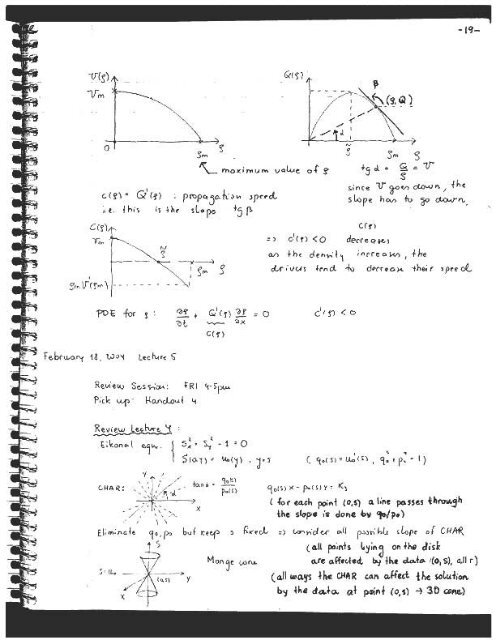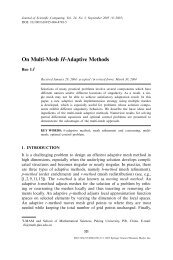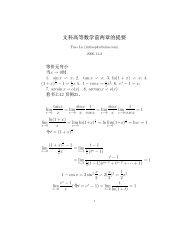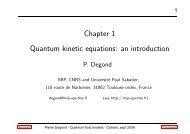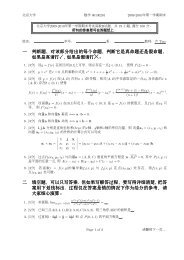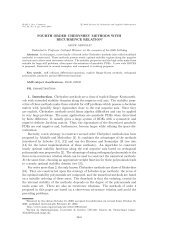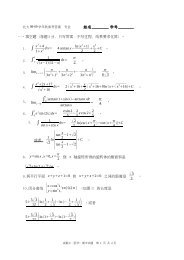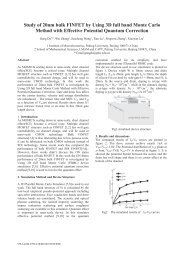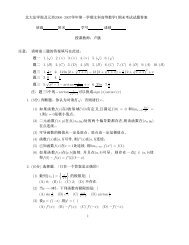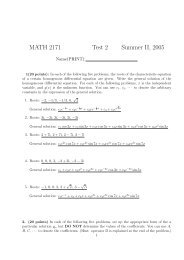Pick-up Time: Monday, May 10, 11
Pick-up Time: Monday, May 10, 11
Pick-up Time: Monday, May 10, 11
Create successful ePaper yourself
Turn your PDF publications into a flip-book with our unique Google optimized e-Paper software.
NAME:<br />
<strong>Pick</strong>-<strong>up</strong> <strong>Time</strong>: <strong>Monday</strong>, <strong>May</strong> <strong>10</strong>, <strong>11</strong>:00am (in class)<br />
Return <strong>Time</strong>: Wednesday, <strong>May</strong> 12, 9:30am (in class)<br />
18.306: Take–Home Quiz # 2<br />
You are NOT allowed to communicate with anyone,<br />
other than the instructor, about this quiz while you are<br />
taking it. So, work on the test by yourself!<br />
You can use any books or notes, but you are NOT allowed<br />
to use calculators, or any software such as Mathematica<br />
or Maple for example, in order to solve the<br />
problems.<br />
Read the problems CAREFULLY, especially the<br />
given HINT(S). Write CONCISE answers, yet JUS<br />
TIFY all your steps. If needed, try to use all sheets<br />
of paper given to you with the test. Cross out what<br />
is not meant to be part of your final answer.<br />
Total # of points: 70.<br />
DO ALL 3 PROBLEMS!
I. (20 pts) [This problem has parts 1, 2, 3.] Consider<br />
the usual conservation law in one space dimension x,<br />
− < x < +, with “density” π = π(x, t) and<br />
“flux” q = q(x, t) = Q(π) + µ · πxx, where<br />
∂<br />
Q(π) = π l+1 ; l > 0, ∂ > 0, µ > 0 (l : pure number).<br />
l + 1<br />
1.(2 pts) Derive a PDE for π(x, t) (show all your steps<br />
in detail).
2.(6 pts) Consider the stretching transformations (ST)<br />
x˜ = π<br />
x, t˜ = t, ˜ = ω π and find relations among<br />
the real ω, κ and θ so that the PDE of part (1) is invariant<br />
under these ST ( > 0). Construct the form of<br />
a similarity solution for π(x, t). When would you expect<br />
such a solution to hold? (You are NOT asked to<br />
derive or solve any equation for the similarity solution<br />
at this point.)
3.(a)(5 pts) Now try to solve the PDE of part (1)<br />
by use of dimensional arguments that ONLY involve<br />
the dimensional quantities π, x, t, ∂ and µ. Define<br />
suitable non-dimensional quantities of the form π/A(t)<br />
and x/B(t); give A(t) and B(t). Construct the form<br />
of a similarity solution and compare with your result<br />
of part (2) above. Derive an ODE for the similarity<br />
solution for arbitrary number l. (You are NOT asked<br />
to solve the ODE or provide any conditions at this<br />
point.)
l .<br />
3(b)(7 pts) In part 3(a) above, take = 2 Derive<br />
a 2nd-order ODE for the similarity solution of 3(a).<br />
Justify and give all conditions needed for the solution<br />
of this ODE. (You are NOT asked to find the solution.)
II.(20 pts) [This problem has parts 1, 2.] Weakly<br />
nonlinear shallow-water waves are governed by the PDE<br />
ut + ω· uux + (κ 2 /3) uxxx = 0, − < x < +, where<br />
ω and κ are positive constants.<br />
1. (8 pts) Notice that this PDE admits constant solutions,<br />
u = u0 = const. We seek an approximate<br />
solution of the form u = u0 + u1(x, t) where |u1| is<br />
“sufficiently small.” Derive a linear PDE for u1. Assume<br />
a solution in the form u1(x, t) = g(kx−t) where<br />
g(β) has period 2λ and cannot be a constant. (Here,<br />
β kx − t.) Show that g is of the form e ±i(kx−t)<br />
and find the dispersion relation = W (k). Give the<br />
gro<strong>up</strong> and phase velocities.
2. (12 pts) Consider a Fourier s<strong>up</strong>erposition of the<br />
waves (“wave packet”) for the g found in part (1) above<br />
and describe it approximately for sufficiently long x and<br />
t. Give conditions in terms of the parameters ω and κ<br />
for the validity of your approximation. Define the caustic<br />
and provide a graphical and analytical description<br />
of the wavepacket near the caustic.
III.(30 pts) [This problem has parts 1, 2.]<br />
1.(15 pts) The two-dimensional (2D) Green’s function<br />
G(x, y; x , y ) for the Laplacian 2 in the rectangle =<br />
{0 < x < a, 0 < y < b} is defined to be continuous<br />
in and satisfy the PDE<br />
Gxx+Gyy = α(x−x ) α(y−y ), 0 < x < a, 0 < y < b,<br />
along with the homogeneous condition G = 0 on <br />
(: boundary of ). Find G in terms of a suitable<br />
series expansion that involves sinusoidal functions in x<br />
via using separation of variables.
2. (15 pts) Consider the PDE<br />
uxx + uyy + 2ux + u = µ · π(u), (x, y) in ,<br />
where u = u(x, y) satisfies the boundary conditions<br />
u(0, y) = u(x, 0) = 0, u(a, y) = A = const., and<br />
u(x, b) = B = const.; π(u) is a nonlinear, bounded<br />
function of u and µ is a positive constant.<br />
2(a) (5 pts) Set u = δ(x, y) · w(x, y) and find a function<br />
δ(x, y) such that the PDE for the new dependent<br />
variable w = w(x, y) does NOT contain any wx and<br />
wy terms.
2(b) (7 pts) Convert the PDE for w that you found<br />
in 2(a) to an integral equation. For this purpose, define<br />
and find a suitable Green’s function; also, define and<br />
find a suitable solution w0( x, y) of the homogeneous<br />
PDE for w that results by letting π 0. Hint: You<br />
may use the result of part (1) for the Green function.<br />
Also, write w0 = w0,1 + w0,2 where w0,1 and w0,2 each<br />
satisfies suitable conditions on ; determine w0,1 and<br />
w0,2 separately in terms of series expansions.
2(c) (3 pts) Solve approximately the integral equation<br />
of part 2(b) for |µ| ≡ 1; your solution should<br />
include terms O(µ) but no higher-order terms.
NAME:<br />
<strong>Pick</strong>-<strong>up</strong> <strong>Time</strong>:<br />
Return <strong>Time</strong>:<br />
18.306 Take–Home Quiz # 1<br />
<strong>Monday</strong>, March 15, 2004<br />
You have 4 hours to do the test.<br />
You are NOT allowed to communicate with anyone,<br />
other than the instructor, about this quiz while you are<br />
taking it. So, work on the test by yourself!<br />
You can use any books or notes, but you are NOT allowed<br />
to use calculators, or any software such as Mathematica<br />
or Maple for example, in order to solve the<br />
problems.<br />
Read the problems CAREFULLY, especially the<br />
given HINT(S). Justify your answers. Try to use<br />
all sheets of paper given to you with the test. Cross<br />
out what is not meant to be part of your final answer.<br />
Total # of points: 30.<br />
DO ALL 3 PROBLEMS!
I. (8 pts) In materials science, the evolution of surfaces<br />
of materials is often studied by use of PDE. In the case<br />
of evaporation dynamics, where material evaporates to<br />
the environment, the surface height h = h(x, y, t) relative<br />
to the xy-plane of reference satisfies a complicated<br />
PDE. For simplicity, it is assumed that axisymmetry<br />
holds, i.e., h depends only on the polar distance<br />
r = ≤ x 2 + y 2 0 and time t > 0, h = h(r, t); h<br />
satisfies the simplified PDE<br />
ht = (A/r)hr,<br />
where A is a positive constant.<br />
Solve this PDE, and discuss why and how any initial<br />
smooth, axisymmetric bump h(r, 0) = H(r), where<br />
H(r) is monotonically decreasing to 0, finally shrinks<br />
to zero as t + →.<br />
Remark: You are asked to find<br />
h = h(r, t) explicitly as function of r and t and discuss<br />
implications of the solution.
II.(<strong>11</strong> pts) Consider the nonlinear PDE<br />
−1 1 − u2<br />
ut = uxx + (ux) 2 , (1)<br />
u<br />
where u = u(x, t), x is a space variable, t is time and<br />
is a positive constant ( > 0).<br />
(a) (6 pts) Convert the given PDE (1) to a linear<br />
PDE. What is that linear PDE? Show all the steps of<br />
derivation in detail. Hint: Find a suitable transformation<br />
w = (u). You are not asked to solve the PDE<br />
for this question (a).
(Continuation of Prob. II.)<br />
(b) (5 pts) Using the result of part (a), solve PDE<br />
(1) for −→ < x < + → and t > 0 with the initial<br />
condition<br />
2<br />
u(x, t = 0) = e −x , −→ < x < +→,<br />
and the boundary condition u(x, t) 0 sufficiently<br />
fast as |x| →. Remark: Beware. You are asked<br />
to give u(x, t) explicitly as function of x and t.
III. (<strong>11</strong> pts) Consider a function u = u(x, t), defined<br />
for 0 x 1 and t 0, that satisfies the PDE<br />
ut − (x − u) 2 ux = 0. (2)<br />
(a) (7 pts) S<strong>up</strong>pose that u(x, t) satisfies the given<br />
PDE (2) with the conditions<br />
u(x, 0) = 0, and u(1, t) = 1.<br />
Find and sketch the characteristics for this problem.<br />
By using the characteristics, derive an explicit formula<br />
for the solution u(x, t) as a function of x and t. Discuss<br />
the behavior of u(x, t) at the point (x, t) = (1, 0).
(Continuation of Prob. III.)<br />
(b) (4 pts) Now consider a u(x, t) that satisfies the<br />
PDE (2), ut − (u − x) 2 ux = 0, but with the conditions<br />
u(x, 0) = 0, and u(1, t) = 1<br />
2 .<br />
Find and sketch the characteristics for this problem.<br />
By using the characteristics, derive an explicit formula<br />
for the solution u(x, t) as a function of x and t. Discuss<br />
the behavior of u(x, t) at the point (x, t) = (1, 0).
18.306: Advanced Partial Differential Equations with Applications<br />
M.I.T. Department of Mathematics Spring 2004<br />
Practice Set 5 Handed out: Friday, 05/07/04<br />
Due: NEVER<br />
You are NOT required to return solutions. None of these problems will be given in Quiz 2. The<br />
description of the references given in parentheses can be found in the Bibliography for 18.306.<br />
41. (a) Show that if the relation = W (k) for a wave gives a phase velocity vph(k) equal to the<br />
gro<strong>up</strong> velocity vg (k), the wave cannot be called dispersive.<br />
(b) Explain in detail why a linear wave with W (k) = ak + b, a, b →= 0: constants, cannot be<br />
dispersive although vph →= vg . Are any discontinuities in data allowed to propagate in this case?<br />
Why?<br />
42. The nonlinear Schrödinger equation (NLSE), which governs the non-relativistic motion of each<br />
atom in an interacting gas, reads<br />
it(x, t) = −xx(x, t) + a |(x, t)| 2 (x, t) − a(x, t), −≈ < x, t < +≈; a = const. > 0.<br />
(a) Substitute (x, t) = A(x, t)e iα(x,t) , where A and β are real functions, and derive two co<strong>up</strong>led<br />
PDE for A and β.<br />
(b) From (a),solve for β by assuming that A is slowly varying in both space and time (i.e., take<br />
A const.) Derive the dispersion relation = (k) for A 1, where k βx and −βt .<br />
Justify that your solution is a dispersive wave. What is the gro<strong>up</strong> velocity?<br />
43. (Levine, Chap. 5, Prob. 5, p. 62.) The gravity-driven motion of a thin fluid film on an inclined<br />
plane is governed approximately by the PDE: ht + (g sin ζ/λ)h 2 hx = 0. In this equation, h =<br />
h(x, t) is the fluid thickness (height from incline) as a function of the coordinate x along the<br />
plane and the time t (t > 0), ζ is the angle of the incline, g is the gravity acceleration, and λ<br />
is the viscosity.<br />
(a) Show that the general solution to the given PDE is given implicitly by the equation<br />
h = F (x − g sin ζ h 2 t/λ), where F is an arbitrary function.<br />
(b) Obtain a particular solution to the PDE that satisfies the initial condition h(x, 0) = κx, for<br />
0 < x < L, and h(x, 0) = 0 otherwise. From this particular solution, derive the approximate<br />
formula h(x, t) (g sin ζ/λ) −1/2 (x/t) 1/2 for t ≡ ≈ and x > 0, which has a similarity form.<br />
Now re-derive the formula in (b) via a similarity solution in 2 alternative ways:<br />
(c) Show that the given PDE is invariant under the stretching transformations x<br />
t<br />
= x,<br />
= t and h = h, where > 0 is an arbitrary parameter. Hence, try a similarity solution<br />
h = T (t) g(θ) where θ = x/t. Find T (t) and g(θ) via substitution into the PDE.<br />
(d) Look for solutions h = c x t β . Find the constants c, α and π by substitution into the PDE.<br />
44. Consider the usual wave equation, utt − c 2 uxx = 0.<br />
1
x<br />
(a) Dimensional arguments suggest a similarity solution of the form u = f(), where = ct .<br />
Find and solve the ODE for f().<br />
x<br />
(b) Substitute u = xβ f() into the PDE, where = and π is real. Find an ODE for f().<br />
ct<br />
45. (Debnath, Prob. 8.14.7, pp. 327, 328.) The Prandtl-Blasius problem for a flat plate in a<br />
uniformly moving fluid is described by the PDE system<br />
uux + vuy = λuyy , ux + vy = 0,<br />
where u and v are the fluid velocity components in the x and y directions and λ is a positive<br />
constant.<br />
(a) Introduce the stream function ξ by (u, v) = (ξy , −ξx) and derive the PDE satisfied by ξ.<br />
(b) In (a) try a similarity solution of form ξ = x 1/2 g(θ) where θ = y x −1/2 . Derive an ODE<br />
for g.<br />
(c) Can you justify in any way, mathematical and/or physical, the form of solution suggested<br />
in (b)?<br />
46. (Levine, Chap. 5, Prob. 3, pp. 60, 61.) Consider the PDE ut = λ(urr + r −1 ur − r −2 u) with<br />
variable coefficients, where r > 0, t > 0, and λ > 0 is a constant; u = u(r, t) is an axisymmetric<br />
function in two space dimensions.<br />
(a) Apply stretching transformations (ST) and find a relation among the exponents so that<br />
the PDE is invariant under ST.<br />
(b) By virtue of (a), try a similarity solution of the form u = r λ f(θ). Define the similarity<br />
variable θ. Derive an ODE for f(θ) for any admissible value of real ψ.<br />
(c) In (b), choose a negative ψ so that the ODE for f contains only f and f terms and no f<br />
term. Solve the resulting ODE by applying the conditions that u(0, t): finite and lim t0 + (ru) =<br />
k: given.<br />
(d) Define w(r, t) ur +r −1 u. Derive a PDE for w. Try a solution of this PDE in the similarity<br />
form w = t −1 g(θ), where θ is the similarity variable of part (b) above. Compare the results<br />
for g with the result of part (c).<br />
47. (a) (Drazin & Johnson, Prob. Q2.<strong>11</strong>, p. 35.) Consider the nonlinear Schrödinger equation,<br />
iut + uxx + λ u|u| 2 = 0, where u = u(x, t) and λ > 0, and apply the ST ˜x = x, t˜ = t and<br />
ũ = β u. Find relations among κ, α and π so that the PDE is invariant under ST. Set κ = 1:<br />
Try a similarity solution u = t λ f(θ). Give ψ and θ and derive an ODE for f.<br />
(b) (Drazin & Johnson, Prob. Q2.8, p. 34.) Determine µ and ω so that u(x, t) = t µ f(xt ) is a<br />
(similarity) solution of Burgers’ equation,<br />
ut<br />
+ uux = uxx. Find and solve the ODE for f with the condition that f ≡ 0 as x ≡ ≈ and<br />
f(0) = −2ν−1/2 .<br />
48. (Carrier & Pearson, Prob. 16.5.1, p. 313.) The following problem arises in the flow of a viscous<br />
heat-conducting fluid along a channel, and illustrates a situation in which it is useful to change<br />
2
the scale of the dependent, as well as the independent, variable. Let u = u(x, y) satisfy the<br />
PDE φuyy − (1 − y 2 )ux + 4y 2 = 0 in the region x > 0, −1 < y < 1, where 0 < φ ∼ 1; u obeys<br />
the conditions u(0, y) = 0 and u(x, ±1) = 1.<br />
(a) Find the solution u = u0 for φ = 0 that satisfies the first one of the conditions, and explain<br />
why this is not acceptable.<br />
− − (b) Introduce a boundary layer near y = −1 by setting ψ = φ (1 + y). Show that u0 = O(φ )<br />
near the boundary layer. This suggests writing u = φ−ξ(x, ψ) inside the boundary layer.<br />
Derive a PDE for ξ and determine κ. Give suitable conditions for ξ.<br />
3
18.306: Advanced Partial Differential Equations with Applications<br />
M.I.T. Department of Mathematics Spring 2004<br />
Practice Set 4 Handed out: <strong>Monday</strong>, 04/05/04<br />
Due: NEVER<br />
You are NOT required to return solutions. Some of these problems may be given in Quiz 2. The<br />
description of the references given in parentheses can be found in the Bibliography for 18.306.<br />
31. (Carrier & Pearson, § 1.7, pp. 17, 18.) This problem gives a systematic way to treat a<br />
nonhomogeneous PDE with nonhomogeneous boundary (in x) and initial (in t) conditions.<br />
Describe how you would solve the diffusion equation with a source term, ut = λuxx + w(x, t),<br />
where u = u(x, t), with the conditions u(x, 0) = f(x), u(0, t) = g(t), u(l, t) = h(t), where<br />
0 < x < l and t > 0. Hint: Try to convert the given problem to one with nonhomogeneous<br />
PDE satisfying homogeneous boundary conditions. For instance, you may introduce ξ by<br />
ξ = u − {g(t) + (x/l)[h(t) − g(t)]}. Show that ξ satisfies homogeneous boundary conditions<br />
and derive a new PDE for ξ. Try a Fourier series ξ(x, t) = <br />
n an(t)αn(x). What is αn(x) and<br />
how would you find an ODE for an(t)? What is the condition for an(t)?<br />
32. For given > 0, derive an equation that governs the eigenvalues of the problem<br />
2<br />
→ u + 2 u = u; u(r, 0) = u(a, π) = 0, u(r, ν) = 0; r, π : polar coordinates<br />
where 0 r < a and 0 < π < ν. What are the corresponding eigenfunctions?<br />
33. This problem is an application of eigenvalue theory to statistical mechanics (Bose-Einstein<br />
condensation). Derive an equation for the energy levels per atom in a gas of pairwise interacting<br />
atoms enclosed in an one-dimensional (1D) box. The motion of each atom is governed by the<br />
nonlinear Schrödinger equation, it(x, t) = −xx(x, t) + a|(x, t)| 2 (x, t) − ψ(x, t), 0 < x <<br />
−iEt ξ(x)<br />
L, with the boundary conditions (0, t) = (L, t) = 0 (a, ψ > 0). Hint: Set = e<br />
and describe E so that the given PDE and conditions are satisfied.<br />
34. (Carrier & Pearson, § 3.<strong>11</strong>, pp. 52, 53.) This problem aims to familiarize you with a uniqueness<br />
proof. Give a proof that the one-dimensional (1D) wave equation with a space-dependent<br />
velocity c and a forcing term f, utt − c(x) 2 uxx = f(x, t), has a unique solution u(x, t) in<br />
0 < x < l, t > 0 if u satisfies<br />
u(0, t) = a(t), u(l, t) = b(t), u(x, 0) = h(x), ut(x, 0) = p(x).<br />
l<br />
dx [π2 t /c2 + π2 1<br />
Hint: Define the integral I(t)<br />
= 0<br />
x], where π is any solution of the given PDE<br />
2<br />
with f 0 that satisfies π(0, t) = π( l, t) = 0. Show that dI/dt = 0. Take π = u − v where u<br />
and v satisfy the given PDE and all given conditions. Infer that π 0. What is the physical<br />
meaning of I in the case of a stretched string?<br />
35. Find explicitly the Green function G for outgoing waves in 3D that is specified by the solution<br />
2<br />
of the form w = G(r; r )e it of the PDE wtt − c 2 → w = −β(r − r ) e it , where r = (x, y, z) is<br />
the position vector in the 3D infinite space.<br />
1
36. Define and find the Green function G(x, t; x , t odinger equation<br />
) for the time-dependent Schr¨<br />
it(x, t) + xx(x, t) = V (x, t)(x, t), with the initial condition (x, 0) = a(x). Convert the<br />
given initial-value problem into an integral equation. Show the connection with the Green<br />
function defined in class for the diffusion equation.<br />
<br />
37. Define the Green function G(x, y; x y<br />
<br />
) for the nonhomogeneous PDE uxxxx − uyy = ζ(x, y) in<br />
the strip (−≡ < x < ≡, 0 < y < 1), where u satisfies prescribed boundary conditions at y = 0<br />
1 1<br />
and y = 1, and is bounded as |x| ≡. Calculate G(0, ; 0, ) in terms of a (convergent) single<br />
2 2<br />
series. Hint: G(x, y; x , y ) should satisfy corresponding homogeneous conditions (why?). Use<br />
Fourier Transform in x and the Residue Theorem.<br />
<br />
38. (Carrier & Pearson, Prob. 9.3.9, p. 147.) A two-dimensional (2D) Green’s function G(x, y; x , y )<br />
for the Laplacian → 2 in a finite region is defined by<br />
<br />
Gxx + Gyy = β(x − x ) β(y − y ); G = 0 on boundary.<br />
Show, by using separation of variables, that for the case of the square region 0 < x < l, 0 <<br />
y < l, G is given by<br />
sin(nνx <br />
/l) sin(nνx/l)<br />
G = {cosh[nν(l − y − y )/l] − cosh[nν(l − |y − y |)/l]}.<br />
nν sinh(nν)<br />
n=1<br />
39. (Levine, Chap. 5, Prob. 4, pp. 61, 62.) Show that the first-order nonlinear PDE uy + uux = 0,<br />
where x and y are space variables, has a general solution of the implicit form u = F (x − uy),<br />
where F is arbitrary. On the other hand, dimensional considerations suggest a similarity form<br />
u = H(x/y). Find H explicitly through an ODE in δ = x/y and verify its agreement with the<br />
exact solution of the PDE when F () = and y ≤ 1.<br />
40. (Levine, Chap. 5, Prob. 8, pp. 64–66.) The PDE Ct = k(C n Cx)x, where C = C(x, t), k > 0<br />
and n: integer, is relevant to certain models of thermal conduction with a nonlinear heat flux,<br />
and of filtration which concerns gas flows through porous media. Consider a solution C to this<br />
PDE that, at t = 0, vanishes everywhere except in some neighborhood of the origin x = 0,<br />
and also obeys the relation C(x, t) dx = Q = const., which often expresses conservation of<br />
−<br />
total mass.<br />
1 1<br />
(a) Verify that the variables (kt/Q n+2<br />
2 ) n+2 C and = x(Qnkt) −<br />
<br />
are dimensionless.<br />
1<br />
(b) Find particular solutions of the form C = [Q 2 (kt) −1 ] n+2 f (). What is the ODE and<br />
constraints (conditions) satisfied by f ? Is f even or odd? Find unique particular solutions for<br />
the following cases: (i) n = 1, and (ii) n = −1. Notice the difference in the nature of the two<br />
solutions. How do these solutions behave as t ≡? Hint: Apply C 0 when |x|: suff. large<br />
( C: continuous), and the integral constraint involving Q in order to determine the integration<br />
constants of the ODE.<br />
(c) Show that, if C(x, t) is a solution of the given PDE, then (αω −2 ) 1/n C(ωx, αt) is also a<br />
solution, where ω and α are constants and α > 0.<br />
2
18.306: Advanced Partial Differential Equations with Applications<br />
M.I.T. Department of Mathematics Spring 2004<br />
Practice Set 3 Handed out: Wednesday, 03/17/04<br />
Due: NEVER<br />
You are NOT required to return solutions. Some of these problems may be given in Quiz 2. The<br />
description of the references given in parentheses can be found in the Bibliography for 18.306.<br />
21. (Carrier & Pearson, Prob. 13.<strong>10</strong>.3, p. 255.) The equations of the two-dimensional isentropic<br />
compressible flow (characterized by entropy S=const.) are<br />
ψt + (ψu)x + (ψv)y = 0, ψ(ut + uxu + uy v) = −c 2 ψx, ψ(vt + vxu + vy v) = −c 2 ψy ,<br />
where c = c(ψ). Discuss the characteristic surfaces in the (x, y, t) space.<br />
22. (Carrier & Pearson, Prob. 13.4.8, p. 239.) The equations of the shallow water theory read as<br />
ut + uux + gwx = 0, wt + [u(w + d)]x = 0,<br />
where u is the horizontal velocity (taken as independent of vertical position), w is the wave<br />
height, d is the depth, and g is the gravity acceleration. The second of these equations is already<br />
in the desired form of a conservation law. To interpret these equations as conservation of mass<br />
and momentum, obtain another desired conservation law via multiplying the first equation by<br />
(w + d), the second by u, and adding. Can you obtain conditions on the possible dicontinuity<br />
of u and w (called a hydraulic jump)?<br />
23. (Levine, Chap. 24, Prob. 1, pp. 277, 278.) Show that the wave equation with a mixed derivative,<br />
utt<br />
− c2uxx = −2ωuxt, where ω and c are positive constants, admits the periodic in t solution<br />
u(x, t) = A sin(t − kx). What is the relation between k and (called a dispersion relation)?<br />
Find an approximate formula for u(x, t) for sufficiently small ωx/c and ω/.<br />
24. (a) [Levine, Chap. 4, Prob. <strong>10</strong>, p. 49.] Solve the PDE x 2 uxx + 1 u = utt by seeking particular<br />
4<br />
traveling-wave type solutions of the form u(x, t) = a(x) f(b(x)−t), which allow for x-dependent<br />
wave speeds; f is an arbitrary function, and a and b satisfy appropriate ODE. (You may wish<br />
to take x > 0 and t > 0.)<br />
(b) [Carrier & Pearson, Prob. 3.4.6, p. 44.] A semi-infinite string in x > 0 has a density that<br />
2<br />
varies with x in such a way that the resulting PDE for its displacement u(x, t) is utt = c uxx<br />
where c 2 = c(x) 2 = (A + Bx) 4 ; A and B are known constants. Solve the PDE via the<br />
transformation u = (A + Bx)ξ(x, t) followed by the change of variable = (x/A)(A + Bx) −1 .<br />
(c) [Levine, Chap. 4, Prob. <strong>11</strong>, p. 50.] Show that a particular solution of the nonlinear PDE<br />
ut<br />
= [K(u)ux]x can be obtained in the form u = f(x − vt), which describes a wave form that<br />
travels at constant speed v, where f satisfies a first-order ODE.<br />
25. Find the (unbounded in t) temperature distribution T (x, t) for 0 < x < L and t > 0 given that<br />
Tt<br />
= λTxx and T (0, t) = 0, T (L, t) = ωt and T (x, 0) = 0.<br />
1
26. (Exercise on Fourier transforms.) Find a single-integral representation for uy (0, 0) if u(x, y)<br />
2 2 −ay 2 satisfies the PDE ≡ u − u = f(x, y) for − < x < and y > 0, with f(x, y) = e (b +<br />
x2 ) −1 , and the conditions u(x, 0) = 0 and u(x, ) = 0; a, b and are positive constants.<br />
27. (Carrier & Pearson, Prob. 15.4.6, p. 296.) The steady-state (Tt = 0) temperature T (x, y)<br />
inside the strip (− < x < , 0 < y < L) satisfies the Laplace equation, Txx + Tyy = 0, with<br />
the given conditions T (x, L) = 0 and T (x, 0) = f(x) (where f(x) 0 as |x| ). Use the<br />
Fourier transform in x in order to find T (x, y). Invert the transform by summing residues, and<br />
verify that the result agrees with that obtained by the direct Fourier series expansion method.<br />
28. (Levine, Chap. 35, Prob. <strong>11</strong>, p. 596.) In class I said that the Fourier transform (FT) is generally<br />
applied in variables that take values in the range (−, +). However, one may also apply<br />
FT to a variable in (0, ) when the corresponding function is taken to be zero in (−, 0).<br />
Consider the following example.<br />
A low-frequency electromagnetic field in a conducting medium satisfies approximately the<br />
diffusion equation. Assume that the (scalar) component E(x, t) of a (vector) electric field in a<br />
conducting half space x > 0 (say, sea water) satisfies the PDE<br />
Et = (c 2 /ν)Exx, x > 0, t > 0,<br />
along with the conditions E(0, t) = f(t), E(x, 0) = 0 and E(x , t) 0; ν is the conductivity<br />
and c is the speed of light. By applying FT in the time t and contour integration, find<br />
<br />
an integral representation for E(x, t) in terms of f(t ), 0 < t < t, and then derive the energy<br />
loss formula<br />
c t t ν<br />
f(t ) )f(t<br />
<br />
Q(t) dx ν|E(x, t)| 2 = dt dt<br />
) 3/2 .<br />
0 2 α 0 0 (2t − t − t<br />
29. By applying FT, solve the Laplace equation uxx + uyy = 0 for − < x < and y > 0,<br />
subject to the initial conditions (Cauchy data) of the form u(x, 0) = f(x), uy(x, 0) = g(x). Is<br />
the solution u regular (differentiable) for y > 0? Comment on the convergence of the Fourier<br />
integral. Argue that a small error in the data can cause a large error in the solution for y > 0.<br />
(Therefore, you should conclude that the problem is ill-posed in the sense of Hadamard.)<br />
30. (Levine, Chap. 24, Prob. 2, p. 278.) The pendulum-like oscillatory motions of a fluid column<br />
inside a U-shaped tube in a vertical plane can be described approximately (in linearized form)<br />
by the PDE<br />
ztt − λ(zrrt + r −1 zrt) + (2g/L)z = 0, 0 < r < R, t > 0,<br />
where z = z(r, t) is the displacement relative to the equilibrium level as a function of the<br />
radial distance r from the tube axis and the time t > 0, and g, L and λ denote the gravity<br />
acceleration, length of the fluid column and kinematic viscocity of the fluid. Describe the<br />
appropriate solution z(r, t) subject to the conditions<br />
z(r, 0) = −H, zt(r, 0) = 0, zt(R, t) = 0,<br />
of which the last one expresses a vanishing fluid velocity at the tube wall, r = R.<br />
2
18.306: Advanced Partial Differential Equations with Applications<br />
M.I.T. Department of Mathematics Spring 2004<br />
Practice Set 2 Handed out: Wednesday, 02/25/04<br />
Due: NEVER<br />
You are NOT required to return solutions. Some of these problems may be given in Quiz 1. The<br />
description of the references given in parentheses can be found in the Bibliography for 18.306.<br />
<strong>11</strong>. (Debnath, Prob. 3.6.17, p. 132:) Solve the following equations:<br />
d(y−u) d(u−x)<br />
(a) (y + u)ux + (x + u)uy = x + y. Hint: Use d(x+y+u) = −(y−u) = −(u−x) etc. (why?)<br />
2(x+y+u)<br />
4<br />
(b) xu(u2 + xy)ux − yu(u2 + xy)uy = x .<br />
12. (Debnath, Prob. 3.6.20, p. 132:) Find the general solution of the equation y ux − 2xy uy = 2xu.<br />
In particular, determine the solution that satisfies u(0, y) = y 3 . [Ans. General solution:<br />
yu = F (x 2 + y).]<br />
2<br />
13. [Levine, Chap. <strong>11</strong>, Prob. 7, pp. 126, 127.] (a) Confirm that u(x, y; c1, c2) = c1x + c1y + c2<br />
represents a “complete integral” of the PDE p = q2 (p = ux, q = uy ), where c1 and c2 are<br />
arbitrary constants.<br />
(b) For (a), consider the data x(s) = 0, y(s) = s, and u(s) = s 2 , where s is a real parameter.<br />
Determine c1 and c2 in terms of s, and then give the solution u as a function of x and y only.<br />
14. (Levine, Chap. <strong>11</strong>, p. 126.) Describe the solution to the PDE p − q = a pq (p = ux, q = uy ),<br />
where a is a real constant.<br />
15. In materials science, the evolution of surfaces of materials is often studied by use of PDE. In<br />
the case of evaporation dynamics, where material evaporates to the environment, the surface<br />
height h = h(x, y, t) relative to the xy-plane of reference satisfies a complicated 2nd-order PDE.<br />
For simplicity, it is assumed that axisymmetry holds, i.e., h depends only on the polar distance<br />
r = 2<br />
→ x2 + y 0 and time t > 0, h = h(r, t); it is also assumed that h satisfies the simplified<br />
PDE ht = (A/r)hr , where A is a positive constant. Show that any initial smooth, axisymmetric<br />
bump h(r, 0) = H(r), where H(r) is monotonically decreasing to 0, finally shrinks to zero as<br />
t +≡.[Ans: By use of characteristics, h(r, t) = H( → 2At + r2 ).]<br />
16. (Levine, Chap. 9, Prob. <strong>11</strong>, p. <strong>10</strong>6.) The necessary and sufficient condition that µ(x, y) is an<br />
integrating factor of the ODE<br />
is the following PDE satisfied by µ (why?):<br />
a(x, y) dx + b(x, y) dy = 0 (1)<br />
(µa) (µb)<br />
= . (2)<br />
y x<br />
1
Take a(x, y) = 3xy + 2y 2 , b(x, y) = 3xy + 2x 2 and show that an integral of (2) is<br />
∂(x, y, µ) = µ → x + y = const.,<br />
and thus obtain the general solution to (1). Note: The knowledge of only one complete<br />
integral of (2) suffices to solve (1).<br />
17. (Levine, Chap. 9, Prob. 12, pp. <strong>10</strong>6, <strong>10</strong>7.) Consider the quasi-linear PDE<br />
uux + uy = 0, −≡ < x < ≡, y > 0,<br />
with the initial data u(x, 0) = sechx, −≡ < x < ≡. Show that a differentiable (“regular”)<br />
solution exists so long as y < y , where y is the minimum value of the function<br />
cosh 2 s , s > 0.<br />
sinh s<br />
Describe (with a sketch) the solution u(x, y) for y > y . Recall: sech x = 1/ cosh x.<br />
18. Use characteristics in order to solve the system of PDE<br />
ut + vx = 0, vt + ux = 0<br />
with the initial data u(x, 0) = f (x) and v(x, 0) = g(x).<br />
19. (Debnath, Prob. 6.<strong>11</strong>.12, p. 257.) For one-dimensional anisentropic fluid flow, the Euler equations<br />
of motion read as<br />
pt + <strong>up</strong>x + c 2 ux = 0,<br />
1<br />
ut + uux + + p<br />
x = 0,<br />
St + uSx = 0,<br />
where p = f (, S) is the pressure, u is the velocity, is the fluid density, and S is the entropy.<br />
Show that this system of PDE has three families of characteristics given by<br />
where c 2 (p/)x =const.<br />
dx dx dx<br />
C0 : = u, C+ : = u + c, C− : dt = u − c,<br />
dt dt<br />
20. A uniform solid sphere with radius a is kept initially (t = 0) at constant temperature T = T0 .<br />
At all later times t > 0 the surface temperature of the sphere, at r = a, is maintained at<br />
T = 0, where r is the spherical coordinate with origin at the center of the sphere. Given that<br />
the temperature distribution inside the sphere satisfies the diffusion equation, Tt = ≥ 2 T ,<br />
where > 0, define and calculate the average temperature Tave inside the sphere for t > 0.<br />
Derive an approximate formula for Tave for sufficiently long times t.<br />
2
18.306: Advanced Partial Differential Equations with Applications<br />
M.I.T. Department of Mathematics Spring 2004<br />
Practice Set 1 Handed out: Wednesday, 02/<strong>11</strong>/04<br />
Due: NEVER<br />
You are NOT required to return solutions for this set. However, these problems may be given in<br />
Quiz 1. Problems 1-3 serve as a review of ordinary differential equations (ODE). The description of<br />
the references given in parentheses can be found in the Bibliography for 18.306, with the exception<br />
of the reference for Problem 3 of this set.<br />
1. Find all solutions of the initial value problem (IVP)<br />
2 <br />
x u (x) + xu (x) − u(x) = 0, u(1) = 0, u (1) = A; x > 1.<br />
Hint: This ODE is the equidimensional equation (see Handout 3).<br />
2. (a) Find the solution of the IVP<br />
<br />
u (t) + q(t) u(t) 2 + p(t) u(t) = 0, u(0) = u0 > 0; t 0,<br />
where p(t) and q(t) are known functions of t.<br />
Hint: See Handout 3; you may use v = 1/u as a new dependent variable.<br />
(b) Consider the special case q(t) = − and p(t) = µ, where µ and are positive constants<br />
(µ > 0 and > 0). Find the relation that u0, µ and should satisfy so that u(t) develops a<br />
singularity at finite time t = ts > 0, i.e., so that u → as t ts. Determine ts in terms of<br />
u0, µ and .<br />
Remark (not needed to solve the problem!): The development of singularities at finite<br />
time is a pathological feature of many nonlinear differential equations (here an ODE). In fact,<br />
an important “million dollar” problem in fluid dynamics is to establish whether solutions of<br />
the celebrated three-dimensional Navier-Stokes PDE, which describe the motion of a viscous<br />
fluid, ‘blow <strong>up</strong>’ or not in time.<br />
3. (Prob. 1.8.3, pp. 14, 15 in G. F. Carrier & C. E. Pearson, “Ordinary Differential Equations”,<br />
Blaisdell, 1968.) As you know, ODE are often used to model physical phenomena. This problem<br />
provides one such example. Occasionally, a meteorite, an artificial satellite, or some other<br />
object enters the Earth’s atmosphere on a path approximately vertical downward. The force,<br />
F , that the atmosphere exerts on such a rapidly moving object is known to be approximated<br />
by F = νV 2 AC/2, where ν is the atmospheric density, V is the speed of the object, A is its<br />
projected cross-sectional area, and C is a constant that depends on the geometry; for blunt<br />
objects C can be taken equal to 2, C = 2. Let us consider objects that only lose a negligible<br />
amount of their mass (by melting, evaporation, etc.) and approximate the atmospheric density<br />
ν by<br />
ν = ν(y) = ν0 e −y ,<br />
where y is the altitude measured in cm, = 750, 000 −1 cm −1 , and ν0 is the sea level density.<br />
(a) Find the ODE for V 2 as a function of y and try to solve it.<br />
1
(b) Determine the speed history of an object, i.e., its speed as a function of time, given that<br />
its speed is V0 at y = 3 × <strong>10</strong><br />
V<br />
7 cm. Typical values of V0 might be in the range 3 × <strong>10</strong>5 cm/sec <<br />
0 < 3 × <strong>10</strong>6 cm/sec.<br />
4. Consider the Laplace equation, uxx + uyy = 0, in the interior of the unit circle, x 2 + y 2 < 1,<br />
where u = u(x, y). S<strong>up</strong>pose that u satisfies the boundary condition<br />
u = 0<br />
ν<br />
along the circle x 2 + y 2 = 1, where (ν, β) are the usual polar coordinates in the plane. Is this<br />
boundary value problem (BVP) ill posed or well posed? Explain.<br />
5. (Levine, Chap. 1, Prob. 7, p. 14.) This problem is an exercise in partial differentiation. Verify<br />
by a direct calculation that the function u(x, t) given by<br />
u(x, t) = 1 c sech 2<br />
where c is a constant parameter, satisfies the PDE<br />
2<br />
<br />
1 ≤<br />
c(x − ct) ,<br />
2<br />
ut + 6uux + uxxx = 0.<br />
Remark (not needed to solve the problem): This solution is the celebrated solitary wave<br />
that moves at speed c in direction x without changing its shape; t is time. The governing PDE<br />
describes shallow water waves (KdV equation). This type of wave was first observed by John<br />
Scott Russell on the Edinburg-Glasgow Canal in 1834.<br />
6. (Levine, Chap. 1, Prob. 1, p. <strong>11</strong>.) By use of the equations x = ν cos β and y = ν sin β that relate<br />
the Cartesian coordinates (x, y) with the polar coordinates (ν, β) ( ν 0 and 0 β < 2∂),<br />
express in polar coordinates and then solve the PDE<br />
yux − xuy = 0.<br />
Note: The solution of PDE is often facilitated by coordinate transformations.<br />
7. Find the general solution in Cartesian coordinates to the 1st-order PDE<br />
Verify your solution by direct differentiation.<br />
2 2<br />
yux − xuy = x + y .<br />
8. (Levine, Chap. 8, Prob. 5, p. 90.) (a) Find the general solution to the PDE<br />
yux + xuy = 2xy.<br />
(b) Find the particular solution that satisfies u = y on the circle x 2 + y 2 = 1.<br />
2
9. Determine the solution u = u(x, y) to the PDE<br />
that satisfies u(1, y) = g(y): known.<br />
2 x − y2 = 4.<br />
uux − uuy = y − x<br />
<strong>10</strong>. (Garabedian, Sec. 2.1, Prob. 2, pp. 22, 23.) Show that the solution of the nonlinear PDE<br />
ux<br />
+ uy = u2 that satisfies u = x on the line y = −x becomes infinite along the hyperbola<br />
3


